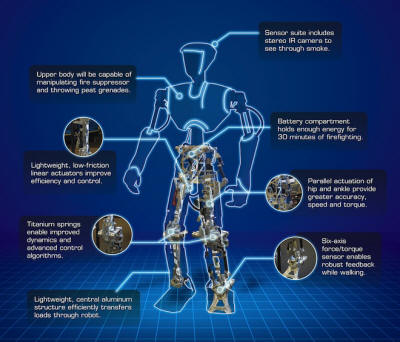|

by Madison Ruppert
March 09, 2012
from
EndTheLie Website
If you thought
legged robots that can outrun you,
spy blimps and
panopticon drones that can monitor
36 square miles at once were bordering on the absurd, get ready to
be amazed.
Now we can add a mechanical firefighter to the rapidly expanding
list of military robots.

The Shipboard Autonomous Firefighting
Robot (SAFFiR), developed by the Naval Research Laboratory, can
not only handle a fire hose but also throw extinguisher grenades,
climb ladders, crawl through cramped spaces and see through smoke.
This is something straight out of the “Terminator” film series,
complete with human-like limbs that respond to environmental
conditions by leveraging the power of cutting-edge sensor
technology.
SAFFiR also boasts titanium springs which act as joints, allowing
for fluid movements. The robotic wonder can even interact with its
human comrades in their firefighting efforts.
It is designed to fight fires on both traditional ships and
submarines - where even a small fire can be extremely dangerous due
to the cramped corners.
The smallest of blazes can be much more difficult to extinguish
without the potential of injury to the crew due to the restricted
quarters.
These new legged robots are a large step forward when compared to
the older military robots which utilized wheels and treads.
The “Cheetah” (below video) is quite astounding but the four-legged
“AlphaDog” autonomous robot makes that look like child play, and SAFFiR will likely raise the bar as well.
Watch the video released by the Defense Advanced Research Projects
Agency (DARPA) and AlphaDog’s creator Boston Dynamics below to see
the beast in action and read the mind-blowing capabilities,
including the ability to “hear” commands from soldiers by checking
out DARPA’s report on the recent tests:
Another robot with shocking abilities
developed by DARPA is the robot created under the Autonomous Robotic
Manipulation (ARM) program which is designed to carry out
human-level tasks without much input and at speeds which would be
thought impossible just years ago:
Yet it appears that it will trump both AlphaDog and the ARM program
through its even more astounding interactions with humans. Indeed,
it is so futuristic that it makes AlphaDog’s ability to hear human
commands seem almost crude.
SAFFiR will be able to detect, understand and respond to human
gestures in order for the robot and humans “to work cohesively as a
team,” according to a statement from the lab.
While AlphaDog does have a visual system, it does not seem to be
nearly as advanced as SAFFiR’s which will be capable of detecting
and responding to pointing and various hand signals, as well as
natural language and other methods of communication.
The robot has been programmed to track the line of sight of a human
in order for it to follow people without requiring the gestures.
This means that when the soldier is visually scanning an area,
SAFFiR follows, allowing for SAFFiR and its human counterpart to
notice a fire at the exact same time.
However, SAFFiR is loaded with infrared cameras as well, which means
that the robot would be able to detect flames through incredibly
smoky air which a human might not be able to see through.
The most major problem with this robot, so far, is that it can only
run for around 30 minutes on its batteries, so if it is not able to
put out a fire in that time, it could very well be consumed.
This robot - which, like its many cousins was funded by the Pentagon
- is expected to be tested in the field in a mere year and a half,
which means it could be loaded onto warships and subsurface vehicles
relatively soon.
SAFFiR was created by the Navy Center for Applied Research in
Artificial Intelligence (NCRAI), according to
PhysOrg, a department
which is part of the Information Technology Division of the NRL.
The NCARAI is tasked with applying artificial intelligence
technology and research to problems critical to both the Navy and
the nation.
Currently, they are developing the algorithms which will give the
robot the ability to naturally interact with humans and give it the
ability to engage in high-level reasoning tasks.
While this might be a great thing to keep people safe and out of
harm’s way, I see a few issues with it.
-
First off, we are pouring
money into these projects when we simply do not have any money to
spend.
-
Secondly, there is no telling what roles SAFFiR could take in the
future, especially considering the advanced abilities to throw
grenades, respond to human gestures and speech, track line of sight,
etc.
This seems like the first step towards a world where there could be
robotic foot patrols and perhaps even robotic policing.
This seems
so far out in the realm of science fiction that it is almost hard to
believe it is even real.
Unfortunately, it is, and just like Unmanned Aerial Vehicles (UAVs),
it could have some much more deadly applications than what it was
first designed for.
Once the technology is ironed out and the costs are low enough, I
could see this
being used for much more than just putting out the
occasional submarine fire, especially once the issue with the
battery life is overcome.
|

